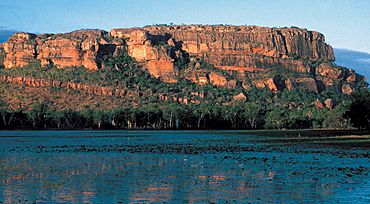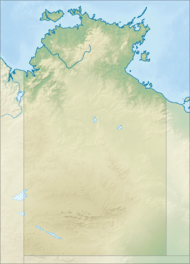Nourlangie Rock facts for kids
Quick facts for kids Nourlangie RockNorthern Territory |
|
|---|---|

Nourlangie Rock
|
|
| Website | Nourlangie Rock |
Burrunggui (also known as Burrunguy) is a special rock formation in Kakadu National Park in Australia's Northern Territory. It used to be called Nourlangie Rock. This area is the traditional home of the Gun-djeihmi speaking people. They believe that important Ancestral beings shaped Burrunggui during the creation time, known as the Dreaming.
Kakadu National Park is a World Heritage Site. This means it is recognized globally for its amazing natural beauty and important cultural history.
Europeans first explored the Burrungui area around 1845. By the 1880s, buffalo hunters arrived. Local Aboriginal people joined these hunting groups. The Traditional Owners shared their Dreaming stories about Burrungui with the Europeans. They also taught them the many names for the natural features. However, the Europeans found it hard to remember all the names. They started calling the area 'Nourlangie', which was a mixed-up version of the local name 'Nawulandja'.
Contents
Ancient Rock Art at Burrungui
Burrungui has many rock shelters with incredible paintings. These artworks show Aboriginal Dreaming stories. You can see Namandi spirits, both male and female figures. One figure even has six fingers on each hand! Many paintings also show European items and animals that were brought to Australia later.
Artists mostly used yellow, white, and red ochre for their paints. Sometimes, red ochre was used like chalk to draw on the rock. Some of the oldest art here includes handprints in red paint. There are also marks from spears thrown at the rock.
The paintings at Burrungui are in two main styles: Mimi and x-ray. The Mimi style is older and shows Ancestral beings from the Dreaming. You can even find pictures of Thylacines (Tasmanian Tigers). These animals have not lived in this area for at least 3,500 years. Seeing many animals, like kangaroos, painted over each other helps experts understand the timeline of the art. However, more research is still needed.
These ancient artworks face many dangers. Tourists can accidentally damage them. Natural processes like ant trails, water, and wasp nests also cause harm. Signs are placed at the art sites to help visitors understand these treasures. They also explain why it is so important to protect them.
Anbangbang Shelter Paintings
The Anbangbang Shelter has some of the most famous paintings in Kakadu National Park. One detailed painting was made by Najombolmi. He was an artist from the Bardmardi clan. He painted these images with his friends in 1963-1964. Najombolmi lived from 1895 to 1967. He is believed to have created about 604 paintings at 46 different sites. Some people also knew him as 'Barramundi Charlie'.
X-ray paintings show animals in a special way. They show the animal's internal organs and bones. Aboriginal artists usually painted these using red and white ochre. One x-ray painting by Najombolmi shows Ancestral beings like Namarrgon, the lightning man. This painting uses a European blue color. This blue pigment likely came from the blue dye Europeans used to keep clothes white. Paintings like this are rare. They help experts figure out exactly when the art was made. It is usually very difficult to date rock art accurately.
Archaeologists dug at Anbangbang in 1981. They found that people first lived there over 6,000 years ago. Sometimes, people used the site as far back as 20,000 years ago. The area became more popular between 800 and 1,200 years ago. This was when the nearby lagoon fully formed.
Nangawulurr Shelter Art
Najombolmi also painted at Nangawulurr Shelter. This shelter was once called Nangaloar. It is on the northern side of Burrungui (Nourlangie Rock). Nangawulurr Shelter shows many different styles of Aboriginal rock art. You can see handprints, Mimi figures in ceremonial clothes, and Ancestral beings. There are also x-ray animals and dolphin-like creatures painted in red ochre.
A unique painting here is a white picture of a two-masted sailing ship. It even has an anchor and a small boat. This might show the early European buffalo hunters in the area. Sadly, because this site was so famous, some visitors in the early 1970s damaged parts of it. Some people also took important cultural items from the site.
Images for kids










